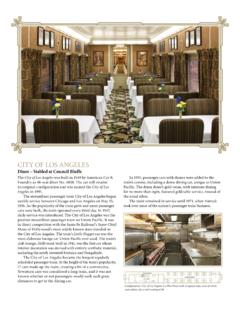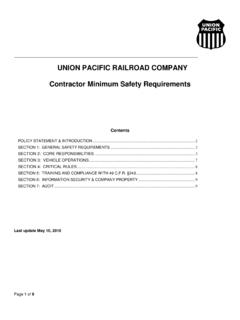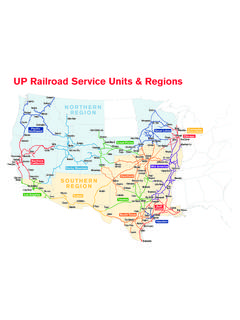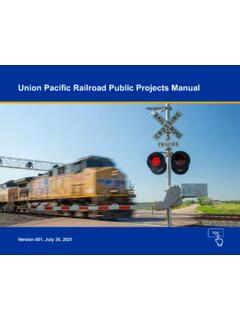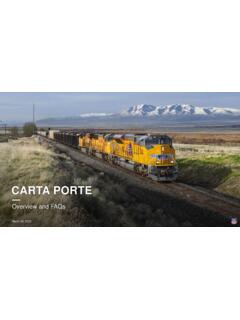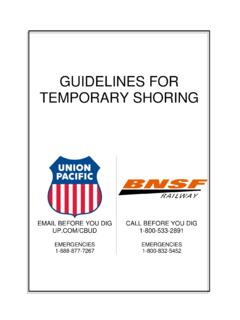Transcription of Safety Rules - Union Pacific Railroad
1 Union Pacific Rules Safety Rules Effective June 1, 2017. Includes Updates as of November 28, 2017. PB-20369. Union Pacific Railroad . All Rights Reserved. These Rules become effective at 0900, Thursday, June 1, 2017. At that time, all previous Rules and instructions that are inconsistent with these Rules become void. STATEMENT: Statement of Safety Policy : GENERAL Safety INSTRUCTIONS. : PERSONAL PROTECTIVE EQUIPMENT. : FIRE PREVENTION. : EXPLOSIVES. : VEHICLE OPERATIONS. : MATERIAL HANDLING. : TOOLS AND MACHINERY. : MECHANICAL LIFTING/PULLING OPERATIONS. : ELECTRICAL. : WELDING. : WALKING/WORKING SURFACES. : WORKING AROUND TRACKS OR BEING ON EQUIPMENT. : HANDLING SWITCHES AND DERAILS. : INTERMODAL RAMP Rules . For business purposes only. Unauthorized access, use, distribution, or modification of Union Pacific computer systems or their content is prohibited by law.
2 GLOSSARY: Glossary INDEX: Index Union Pacific Rules Safety Rules STATEMENT: Statement of Safety Policy STATEMENT: Statement of Safety Policy STATEMENT: Statement of Safety Policy It is Union Pacific Railroad 's policy to conduct its business in a manner that addresses the Safety of employees, contractors, customers and the communities we serve. Union Pacific will strive to prevent all incidents, accidents, injuries and occupational illnesses through the active participation of all stakeholders. The company is committed to continuous efforts to identify and manage Safety risks associated with its activities. Accordingly, Union Pacific 's policy is to: Encourage and support: Employee engagement in workplace Safety ;. A Total Safety Culture;. Care for employees;. Maintain infrastructure and equipment, establish documented Safety management systems, provide training and conduct operations in a manner aimed at safeguarding people and property.
3 Communicate with employees, contractors, communities and customers with respect to their roles and responsibilities surrounding rail Safety . Comply with all applicable laws, regulations, Rules and instructions. Respond quickly, effectively, and with care to emergencies, accidents, or incidents in cooperation with authorized government agencies;. Undertake appropriate reviews and evaluations of its operations to measure progress, foster compliance with this policy and continually improve. Rule Updated Date May 2, 2016. ^Top Union Pacific Rules Safety Rules : GENERAL Safety INSTRUCTIONS. Chapter Introduction GENERAL Safety INSTRUCTIONS. : GENERAL Safety INSTRUCTIONS. : Safety Responsibilities : Comply With Instructions : Job Briefing : Removal of Unauthorized Persons : Criminal Activity : Lifting and Moving Material : Lifting with Two or More Employees : Protection of Body Parts : Safety Around Machines and Equipment : Door or Hatch Operation : Cabinets : Office Equipment and Furniture : Protruding Objects : Energizing Machinery : Damaged or Defective Machinery : Compressed Air / Gas : Drop or Throw Objects : Rail Under Tension : Fusees : Air Contaminants : Internal Combustion Engines : Spills : Skin Protection : Hazard Communication Standard : Drums and Containers : Working with Refrigeration Systems : GENERAL Safety INSTRUCTIONS.
4 GENERAL Safety INSTRUCTIONS. Rule Updated Date July 2, 2013. ^Top : Safety Responsibilities Safety Responsibilities Ref. Rule(s) Employees are empowered to work safely and must: Be responsible for personal Safety and accountable for their behavior. Correct or protect any unsafe condition or practice and report to proper authority. Maintain situational awareness. Work within the limits of physical capabilities. Excessive force must not be used to accomplish tasks. Rule Updated Date July 2, 2013. ^Top : Comply With Instructions Comply With Instructions Ref. Rule(s) Employees must comply with instructions contained in company publications and required documents. Rule Updated Date July 2, 2013. ^Top : Job Briefing Job Briefing Ref. SRM A. Job Briefing Requirement Section R. Job briefing must be conducted: With all individuals involved in the task before work begins.
5 If work plan or work group changes. B. Conduct Job Briefing Job briefing must: Consider existing and potential hazards that might be involved as a result of: Weather. Scope of work. Tools and equipment. Identify PPE requirements. Assign responsibility. Explain group / individual assignments, while considering abilities and experience. Be aware of work groups and equipment in work area. Identify job location. Verify understanding of instructions and assignments. For complex jobs: Brief only a portion of the job. Conduct additional briefing(s) as the job progresses. Complete and sign the job briefing document when applicable. Rule Updated Date July 2, 2013. ^Top : Removal of Unauthorized Persons Removal of Unauthorized Persons Ref. RMCC Unauthorized persons or trespassers on company property must be told to leave the premises, unless 888-877-7267 confronting the person(s) would be unsafe.
6 If the person(s) refuse to leave, or if confronting the person(s) would be unsafe, request immediate assistance from Railroad Police (RMCC) or local law enforcement authorities. When possible, Railroad Police must be advised of all unauthorized persons or trespassers on company property. Rule Updated Date July 2, 2013. ^Top : Criminal Activity Criminal Activity Ref. RMCC Immediately contact Railroad Police (RMCC) or local law enforcement authorities to report suspected 888-877-7267 criminal activity on company property. Rule Updated Date July 2, 2013. ^Top : Lifting and Moving Material Lifting and Moving Material Before lifting or moving: 1. Check the load for size, weight, stability, and grip. 2. Make sure the pathway to be used is clear of obstructions, debris or other conditions which may cause loss of footing. 3. Inspect the area where material will be placed, preferably at waist height and without reaching.
7 4. Choose the proper lifting technique ( , squat, semi-stoop, or balanced one-hand lift). Each person is responsible for determining their lifting limitations. Obtain additional help or mechanical assist device(s) to lift or handle heavy or awkward objects. While lifting, observe the following principles: Ensure secure footing and a good grip on the materials. Keep the object close to your body. Keep your upper body erect. Lift smoothly do not use jerky motions. Do not lift and twist at the same time. Rule Updated Date July 2, 2013. ^Top : Lifting with Two or More Employees Lifting with Two or More Employees Conduct a job briefing before lifting to define: Responsibilities. Techniques for the type of lift being performed. Which individual (positioned at either end) will give commands for all movements (lifting, walking, lowering, or throwing).
8 When possible, avoid walking backward or sideways. Rule Updated Date July 2, 2013. ^Top : Protection of Body Parts Protection of Body Parts Do not place hands, fingers, feet, legs or any part of your body in a position where they might be struck, caught, pinched or crushed. Rule Updated Date July 2, 2013. ^Top : Safety Around Machines and Equipment Safety Around Machines and Equipment Ref. SRM When tools, equipment or machinery becomes jammed or obstructed in any manner, it must be stopped Section H and lockout / tagout procedures followed. Do not enter areas where you could be caught in the operation of machinery or equipment. Rule Updated Date July 2, 2013. ^Top : Door or Hatch Operation Door or Hatch Operation Ref. Rule(s) When opening or closing door or hatch: Visually inspect for obstructions before operating. Use handle or grab iron only.
9 Keep body parts clear of sides and edges and observe while operating. Do not use feet. Use caution as wind or slack action may cause doors or hatches to slam shut. Rule Updated Date June 1, 2017. ^Top : Cabinets Cabinets The contents of cabinets must be arranged and distributed so as to not make the cabinet top heavy. Drawers on cabinets, desks, tool boxes, etc., must be closed when not in use. Do not open more than one drawer at one time. Rule Updated Date July 2, 2013. ^Top : Office Equipment and Furniture Office Equipment and Furniture A. Paper Cutters Exercise caution while operating paper cutters, trimmers and power paper punches. Keep fingers clear of cutting blades and make sure blade guards are in position. Paper cutter blades must be left in the closed position and secured after use. B. Defects Report sharp edges, splinters or defective parts on office furniture or equipment for repair.
10 If unsafe, appropriate action must be taken to protect the hazard. C. Cords Permanent installations of equipment with cords (telephone, electrical, computer, etc.) in walking areas must be encased. Action must be taken to protect temporary installations. D. Chairs, Benches, Tables and Desks Do not stand on chairs, benches. Unsafe chairs or benches must not be used. Chairs must not be repaired or altered in any way except by an authorized repair service. While seated in a chair, all chair legs must remain in contact with the floor. Do not sit or stand on tables or desks. Rule Updated Date June 1, 2017. ^Top : Protruding Objects Protruding Objects Remove or flatten protruding objects (nails, screws, banding, etc.) prior to handling materials or performing duties. Rule Updated Date June 1, 2017. ^Top : Energizing Machinery Energizing Machinery Inspect affected areas and ensure it is safe before turning on electricity, gas, steam, fuel oil, air, water or putting any machinery in operation.

